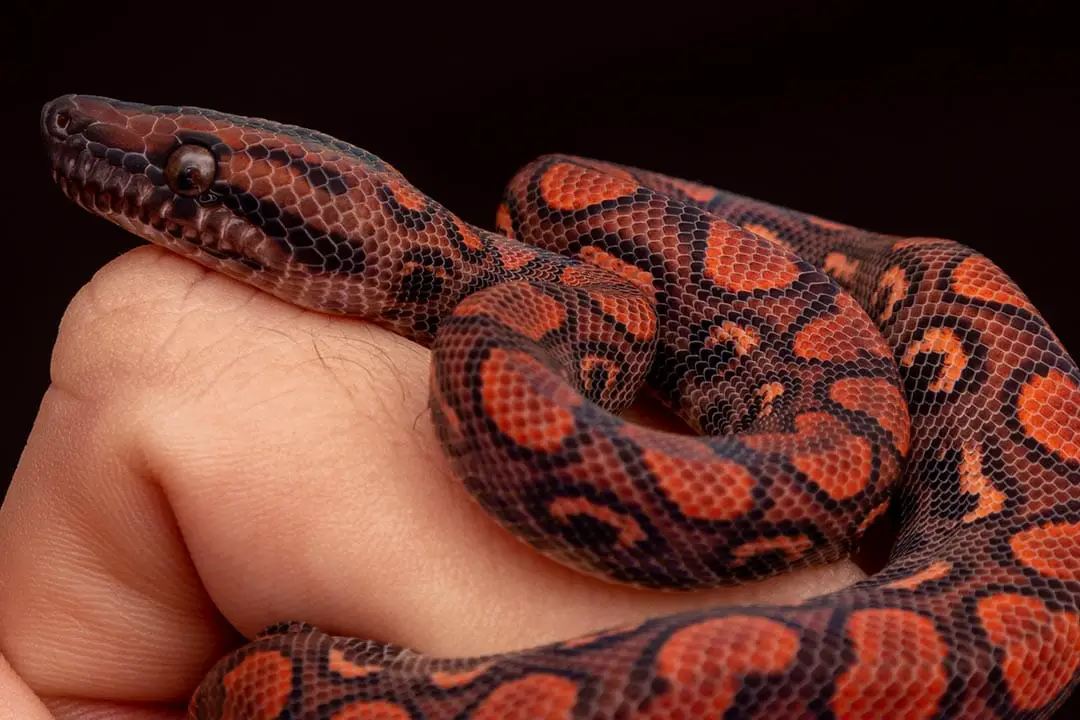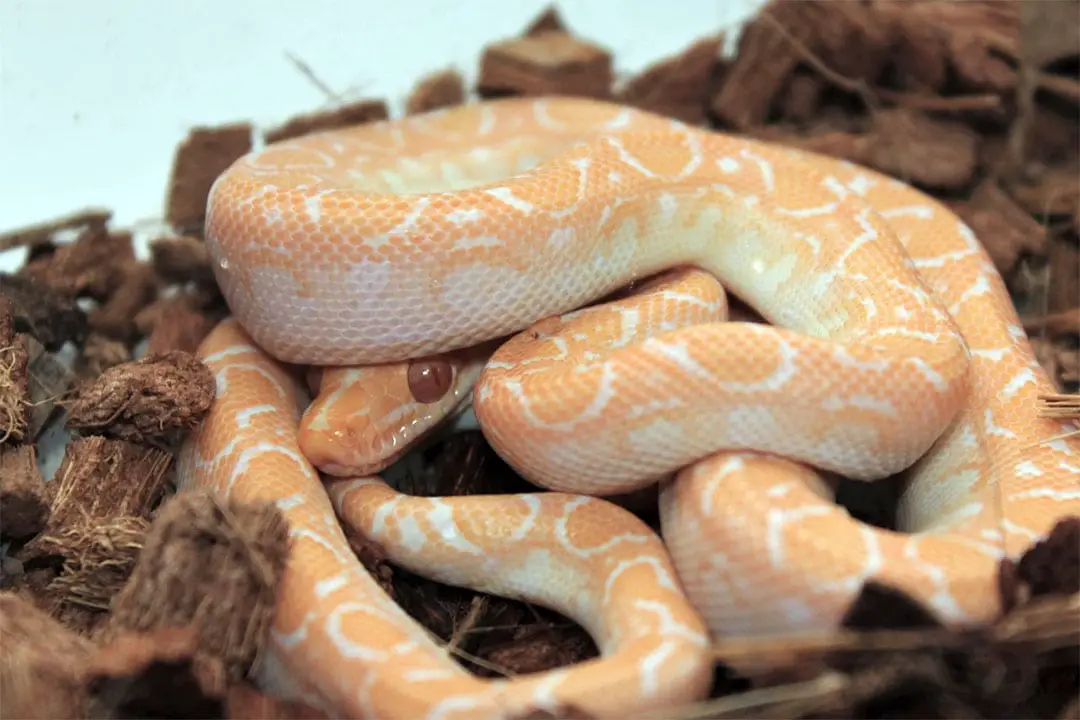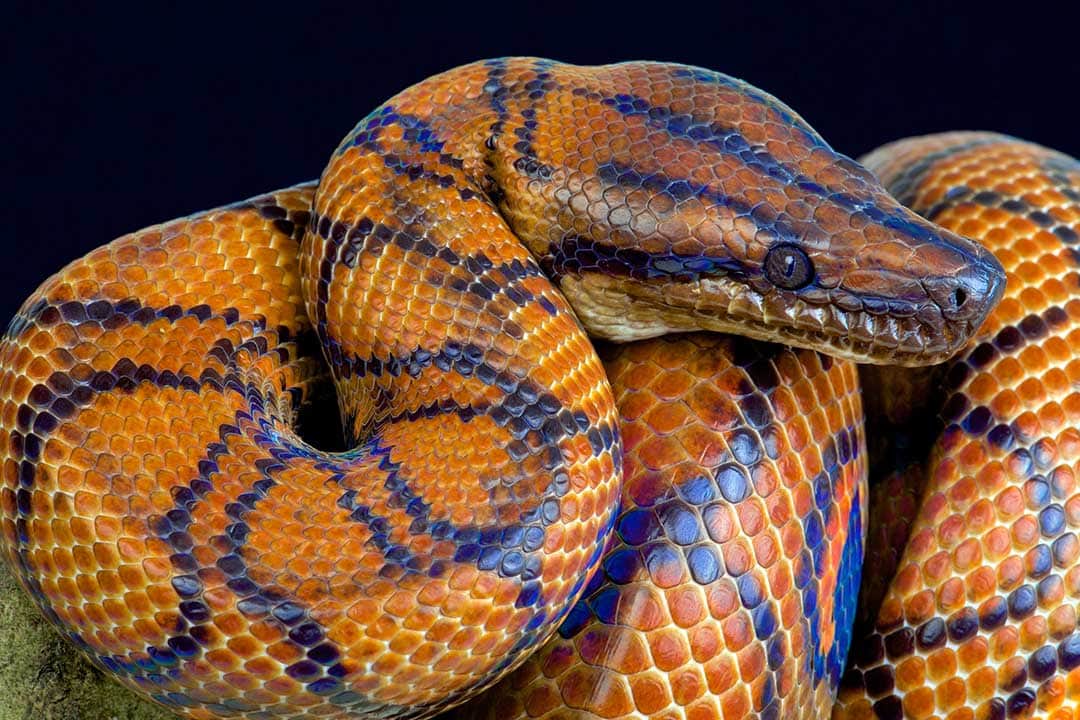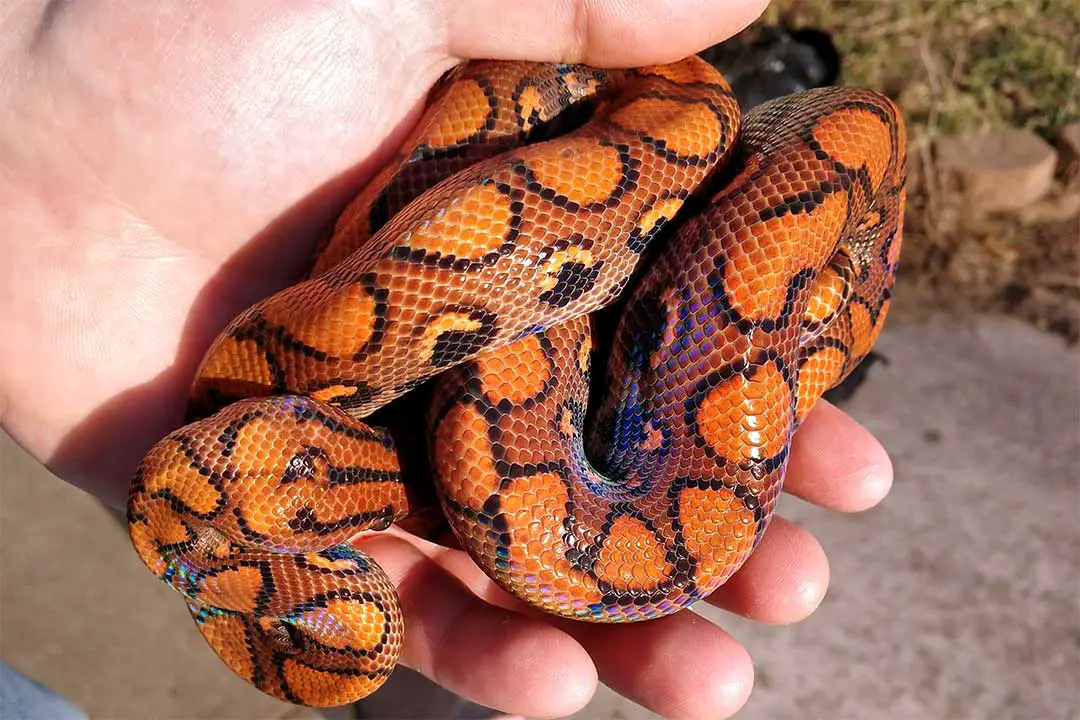The Brazilian rainbow boa (Epicrates cenchria) is a stunning animal with an iridescent sheen to their scales.
The Brazilian rainbow boa has stronger patterning than the related Colombian rainbow boa. In the wild, these are primarily terrestrial animals that live in stable temperatures and humidity.
In captivity, you need to mimic their natural environment and offer plenty of enrichment.
This care sheet will help you learn what your new pet needs to stay healthy.
Housing
Housing your snake is the first and most important step to keeping your pet happy. You need to maintain the right temperatures and humidity to keep your snake healthy.
Enclosure
Brazilian rainbow boas are primarily terrestrial snakes. They will appreciate more floor space over height.
However, you should still offer climbing opportunities for your snake since they enjoy climbing. Live plants or artificial greenery will help fill space and let your snake feel secure.
Live plants are great for humidity levels, but they can be easily crushed by this species.
Plan on offering plenty of shelter and options for your new pet.
You will learn by observing what your snake appreciates. Look for enclosures that open from the front, lock securely, and hold humidity well. Avoid fish tanks as they are not secure enough, not well ventilated, and access from the top will stress them out.
Enclosure for Baby and Juveniles Rainbow Boas
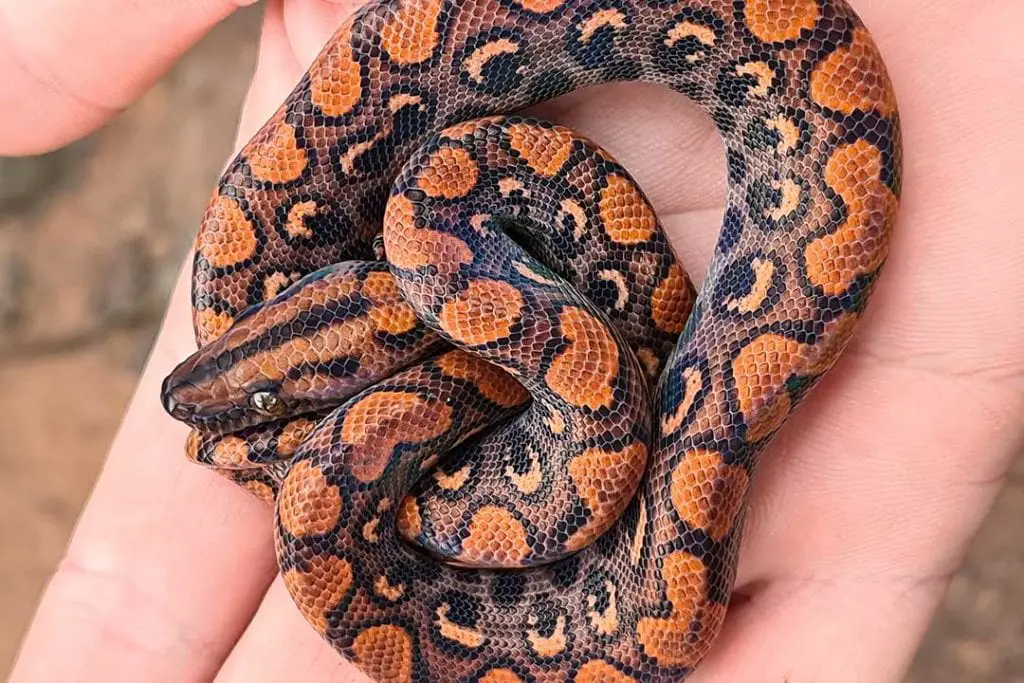
Baby brazilian rainbow boas are born at a length of about 15 to 20 inches. This means you will want a longer enclosure to give your young boa plenty of space as it grows.
A 24 inches long enclosure is a good size for a young Brazilian rainbow boa. These snakes will typically reach 36 to 40 inches by a year old, and they will reach 4 feet in length between 2 and 4 years of age.
This means you need to stick with a larger enclosure unless you want to replace the enclosure often.
Always move a juvenile to a bigger enclosure once it is about twice the length of the longest side of the enclosure at the latest.
A 24X24X18 terrarium is a good option for a young rainbow boa. It has a raised bottom to allow for under-tank heating and has a secure lock on the double doors. This should last until your snake is ready to move to its adult enclosure.
Enclosure for an Adult Rainbow Boa
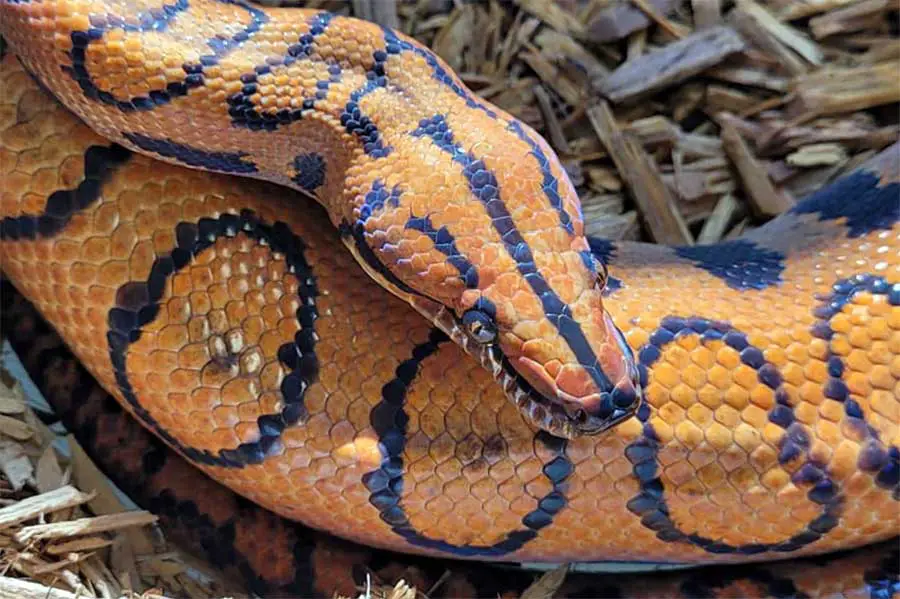
Adult Brazilian rainbow boas need a pretty large enclosure. They range in size from 4 to 6 feet as adults. Females are typically larger than males.
Ideally, your enclosure will be at least as long as your snake and half its length in width and height to allow it plenty of room to move around.
48x24x24 inches is the minimum glass cage enclosure size for adult brazilian rainbow boas. If you have a female, look for something that is about 6 feet long since she will likely be cramped in a smaller enclosure.
If your snake is larger, look into a custom enclosure. Just make sure it can handle high humidity. Wood is popular for snakes that need longer enclosures, but wood can rot quickly in high humidity.
Substrate
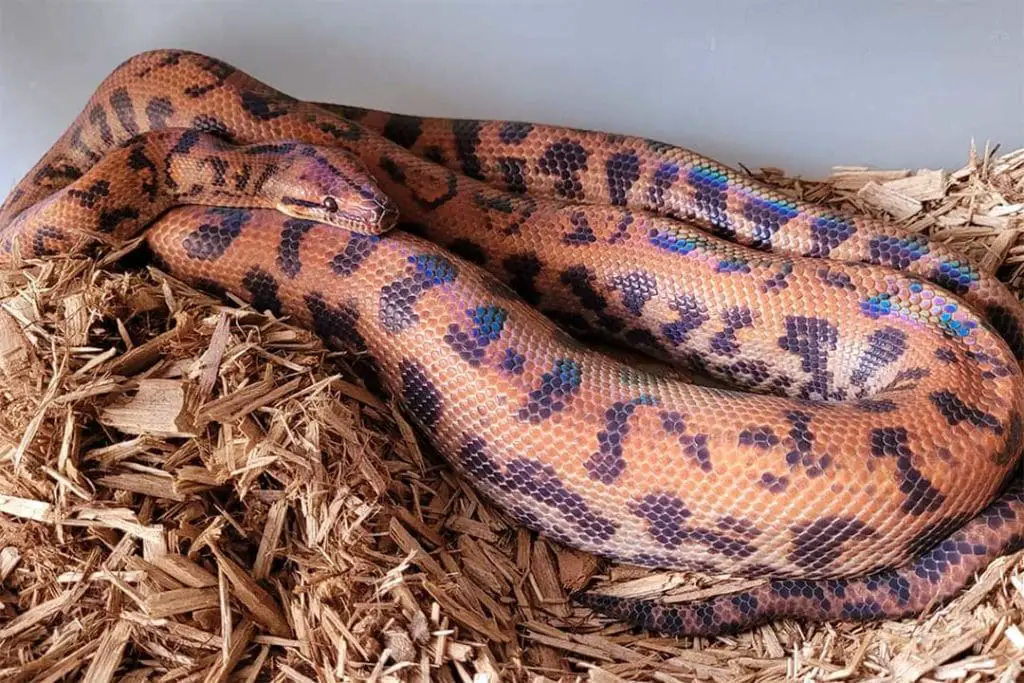
Brazilian rainbow boas need a substrate that can handle high humidity. Paper towels or plain paper meant for reptile enclosures like unprinted newspaper works well for snakes that you need to monitor.
It is also a good choice for animals that dislike being bothered for spot cleaning. Otherwise, go with a substrate that holds humidity well.
Reptichip is a great option since it handles humidity without molding. Cypress mulch is also a good choice for holding humidity. If you want to use live plants or a bioactive setup, be sure to select your soil with the humidity in mind.
Never use reptile carpet or aspen. Neither handle humidity that well and most rainbow boas will dislike them. Avoid any product with aromatic woods such as cedar and pine since this can cause respiratory infections.
If you can smell something, it is likely incredibly strong to your snake.
Heating
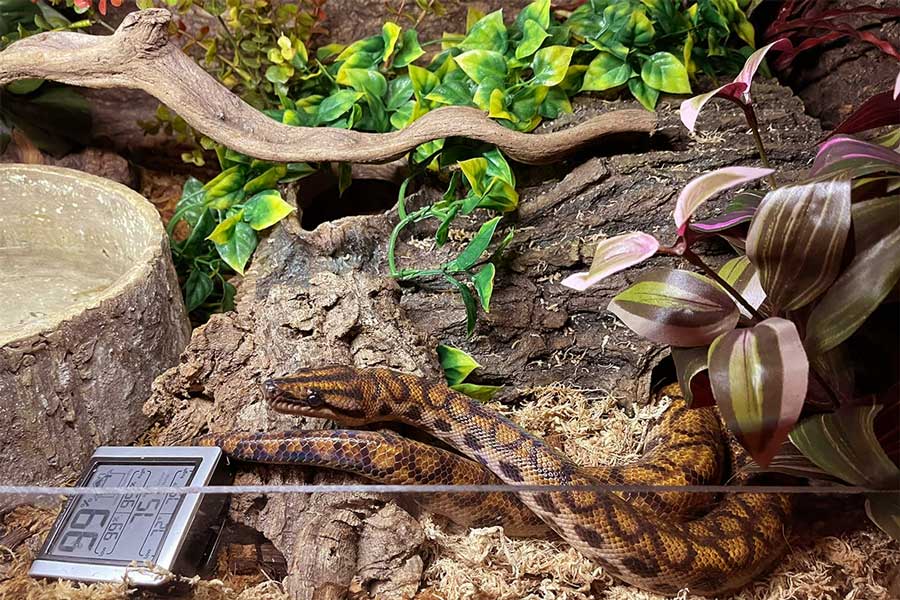
Heating is important for these tropical snakes, you should create a temperature gradient inside the terrarium, so they can move and regulate their body temperature.
The correct temperature settings for a brazilian rainbow boa are a warm side of around 85 degrees Fahrenheit and a cool side of around 72-75 degrees Fahrenheit.
This gives your snake plenty of choices to regulate its temperature. Remember that snakes are cold-blooded and need to rely on the surrounding air to regulate their internal temperature. Never allow your rainbow boa to get over 90 degrees.
Brazilian rainbow boas do not deal with high heat well.
In captivity, they cannot escape the heat as easily and risk overheating if you are not careful with them.
Since they are terrestrial, a heat mat under the tank works well, just make sure your snake cannot lay on it directly or it may overheat.
You should have this plugged into a thermostat to avoid your snake becoming overheated. If you live in a very cold climate, you can use a heat lamp to help warm the enclosure.
Stick with a ceramic heating bulb since this species is nocturnal and dislikes bright lights. Try to use this as a last resort since it will dry out the enclosure.
This species needs very high humidity, so this can damage the snake if you aren’t careful. Keep an eye on your temperatures with a heat gun.
Lighting
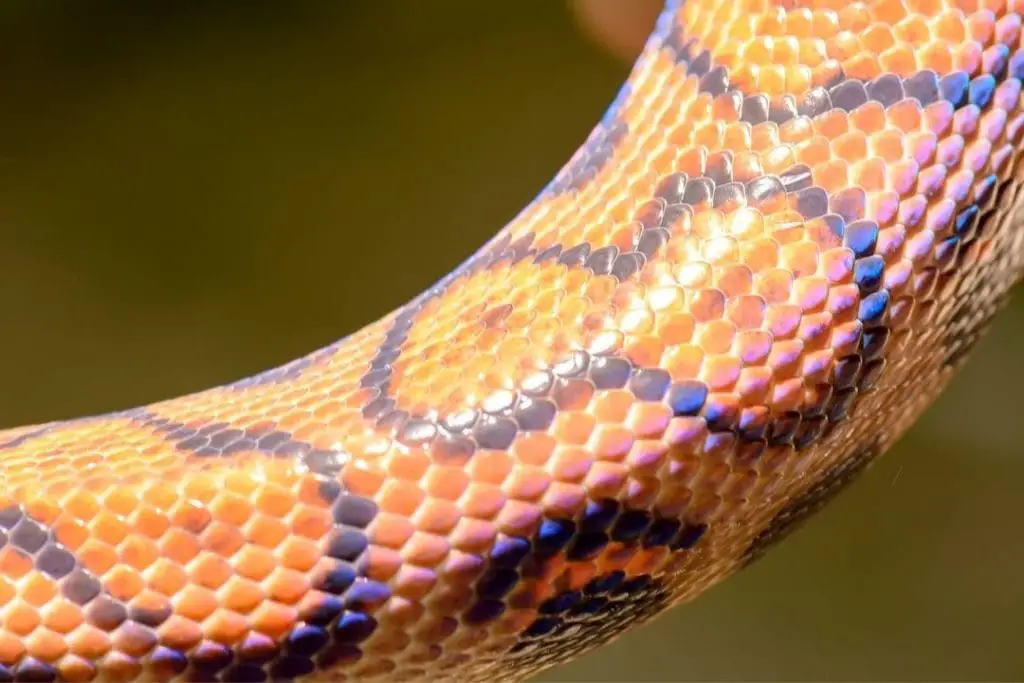
Brazilian rainbow boas are nocturnal and do not require special lighting.
Their scales have microscopic ridges on the surface, which act like a prism to reflect light and create the beautiful rainbow iridescent effect, and a light will help display this beautiful snake’s skin reflections.
If you want to see your pet more easily, and show off that rainbow glow, stick with lighting that will not heat the enclosure like LEDs. You should also put this on a timer so it is not lighting brazilian rainbow boas for more than 12 hours a day.
Shelter
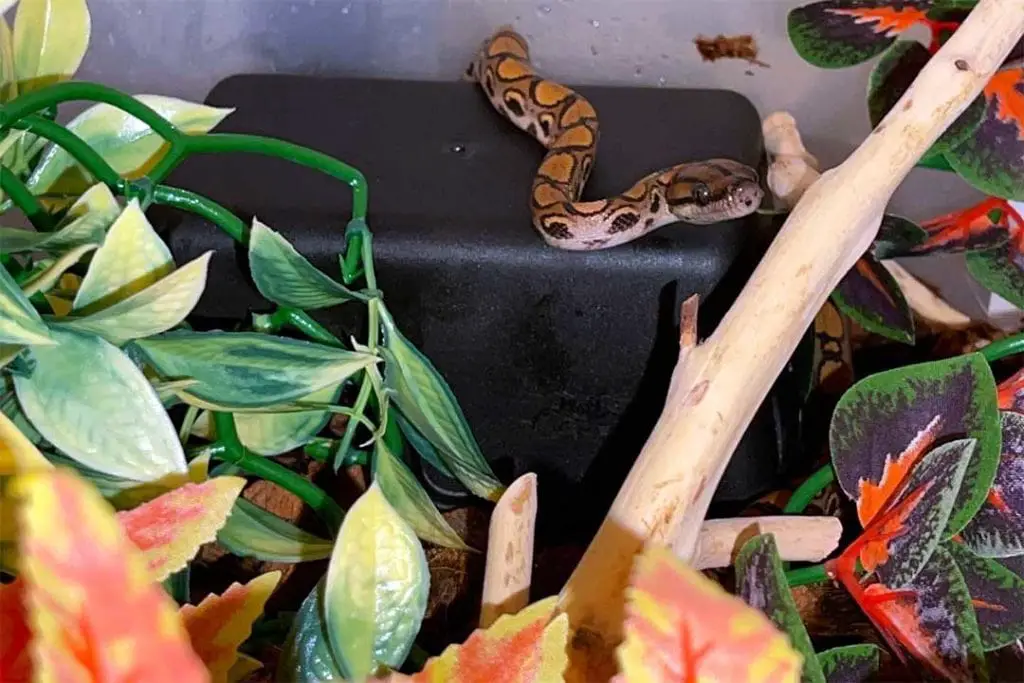
Rainbow boas are typically shy animals that get stressed if they feel too exposed. If you have a glass enclosure, be sure to use one of the available backgrounds or cling paper to block off three sides and give your pet more security.
You will also need at least 2 hides that will hold the whole snake without much room to spare. This is a great option that can also function as a humid hide.
You can buy larger hides for adult rainbow boas, and up the size once your snake outgrows this one. Place a hide at each side of the enclosure. Be sure to add things like greenery and branches to fill space and make your snake feel more secure.
Baby rainbow boas will enjoy smaller hides like coconuts, hollow wood hidings, large cork bark tubes and similar hides.
Snakes love a cluttered enclosure since they feel less exposed.
Water
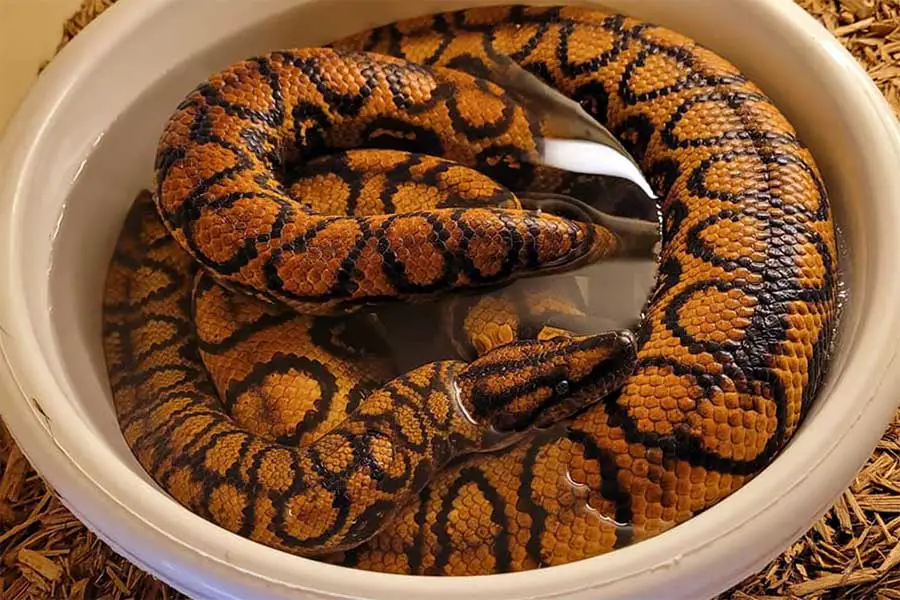
Brazilian rainbow boas need clean water available at all times.
Your snake will drink this water and soak in it as well. Look for a bowl that will hold your whole snake and won’t tip over. This will also help keep up the humidity in your enclosure.
Something like this is a good option for a young snake.
Humidity
Keeping the humidity high is very necessary for rainbow boas. If the humidity is too low, they will suffer from dented eyes, dehydration, and stuck shed.
This can kill them if it goes on too long. Regular misting can help keep the levels up.
The humidity for a Brazilian Rainbow Boa should be between 75 and 90%.
Keep an eye on your snake and the levels. You can block parts of the screen cover to help keep maintain the humidity brazilian rainbow boas require. A humid hide filled with damp sphagnum moss or green moss can ensure healthy shedding:
Enclosure Maintenance
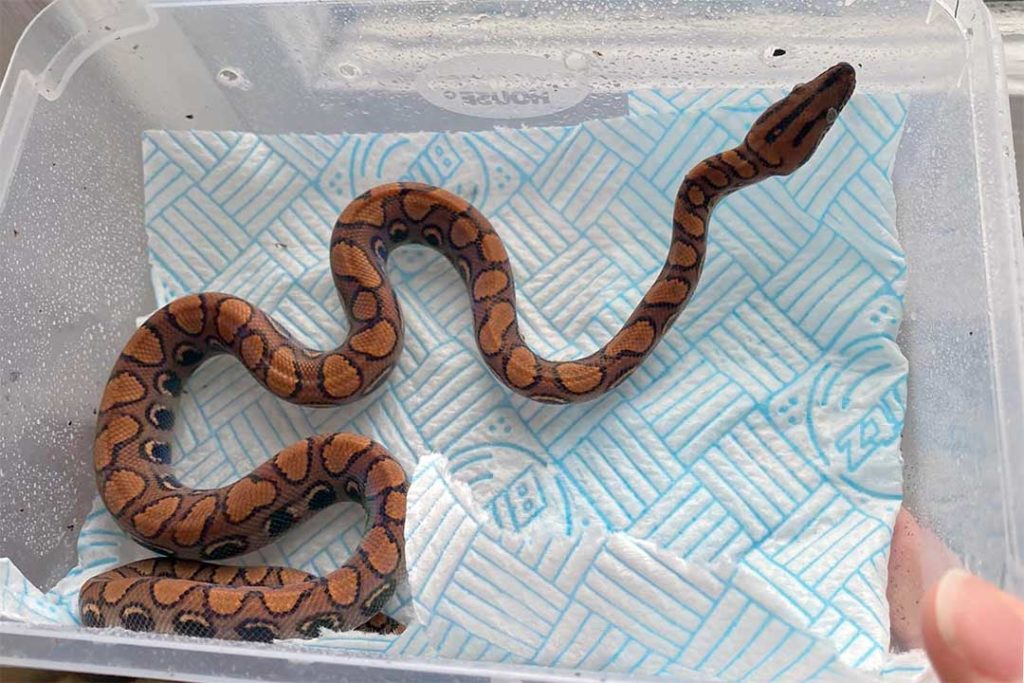
Regular cleaning is an important part of proper Brazilian rainbow boa care, it is needed to keep your snake healthy in the long term. You should be checking for feces and urine daily and spot cleaning.
Replace any substrate you remove. You should also give fresh water daily. If your snake defecates in the water dish, remove it and sanitize it before you return it.
Washing the water bowl with hot water and soap is a good idea every week.
Once a month, do a deep cleaning. This is accomplished by turning off the lighting and heating and placing your snake in a temporary enclosure.
You can use a tub with holes melted in and a secure lid or pick something meant for holding reptiles. Next, remove all the decorations and set them aside to clean and sanitize.
Take out all the substrate and scrub the enclosure down. Use a reptile-safe sanitizer to kill any germs. Be sure you have allowed the glass to cool. Spraying cold liquid on hot glass can make it shatter.
Once you have cleaned out the enclosure, dry up any lingering moisture and leave the door open to let it dry. Scrub and sanitize all the decorations.
This includes the hides and the water dish. Check sphagnum peat moss for mold, Toss out anything that is damaged and replace it. Let this dry and fill the enclosure with fresh substrate.
Turn on the heating and put all the decorations back. You can switch things up and add new items to give your snake some enrichment. Fill the water dish and now you can return your snake to the enclosure. Be sure to lock the doors securely or your snake may escape.
Feeding
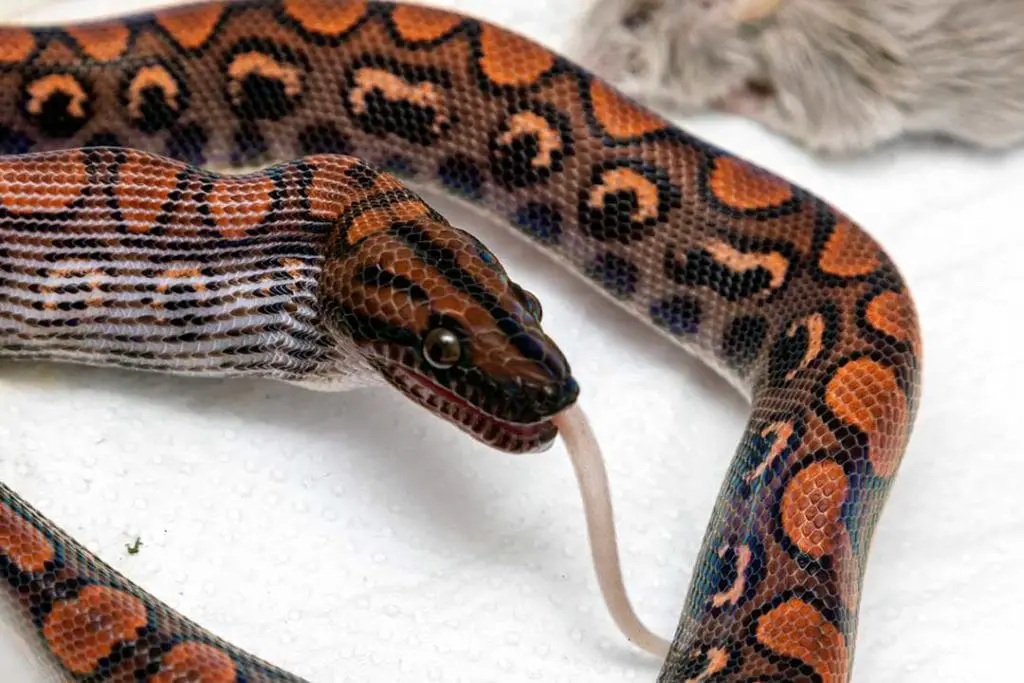
In the wild, Brazilian rainbow boas hunt small mammals, birds, lizards, and potentially aquatic life. In captivity, they are happy on a diet of rodents like most other snake species.
You may want to consider hook training your snake so it does not expect food every time you open the enclosure.
Just gently touch your snake with a snake hook or paper towel tube so it learns that it is handling or cleaning time rather than mealtime.
You should also only offer prey with feeding tongs or you risk being bitten.
Type and Size of Prey
A young Brazilian rainbow boa will eat mice that are no larger than the thickest part of the body. This can be small adult mice, hopper mice or fuzzies depending on the size of your snake when you get it.
A good rule of thumb, if you are buying online, is to select prey that is about 10-15% of the bodyweight of the snake. An adult will likely eat large mice when it is full-grown.
Once again, just check your snake and measure it against the size of the prey. You want to see a small lump in your snake that goes away after about a day or two.
Frozen vs Live

Deciding on what type of prey to offer depends on your snake. Live prey is good for natural feeding responses, but your snake can be seriously injured or killed by the mouse.
They are constrictors, you have to watch the whole interaction until the mouse is dead and consumed. This can be distressing for some people, so you may want to see if you can get your snake on frozen prey.
Many rainbow boas will take frozen and thawed mice so long as they are heated to about 105 degrees before you offer it to the snake.
Frozen mice are a great choice since you can stock up on mice easily.
Defrosting a mouse is easy, just place it in the fridge about a day before you want to feed your snake, and then put it in a bag and immerse it in hot water until it reaches the right temperature.
Some snakes will be stubborn about pre-killed prey. You may need to wiggle it around to get your snake to take it.
Micedirect is a good source for frozen mice, just pick the right size for your snake. Live rodents cannot be shipped, so you will need to find a local source.
Many reptile breeders breed feeder rodents, so ask your local community to find where you can get mice.
Frequency
Juvenile rainbow boas will eat about once a week.
Adults Rainbow Boas can feed every 10-14 days depending on the individual animal. Keep an eye on your snake’s weight and body condition.
If it seems to be getting fat, feed it less frequently. If you can see its spine easily, you need to feed more often. You will figure out the right rate for your snake with a bit of trial and error.
Ambush predators like rainbow boas can survive periods of low prey availability, so your snake can miss a few meals without harming it.
Shedding
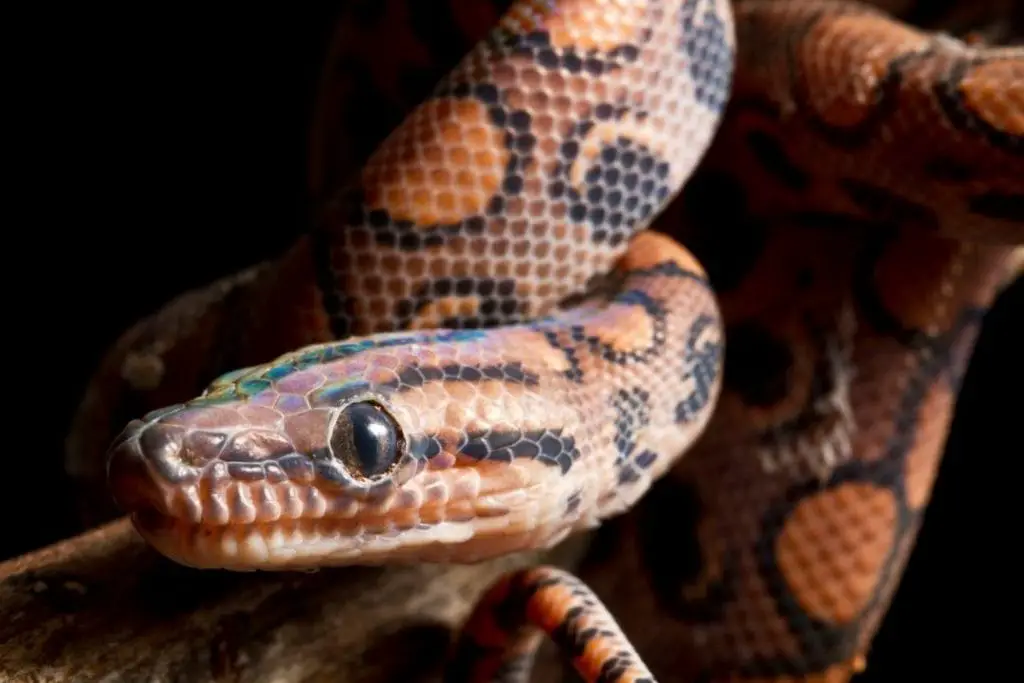
Shedding is how snakes grow longer. A snake’s skin does not grow with it, so it must shed the old one to grow larger. You will see your snake’s color become turn from bright orange to a more dull color and the eyes will look cloudy or blue when it is time to shed.
Mist more frequently and offer a damp hide filled with sphagnum moss on the warm side to help your snake shed more easily. You will see the cloudiness disappear and then your snake will rub on the decorations to help loosen the old skin.
It will crawl right out of the old skin.
Make sure you check that this skin is intact. The eye caps and the tail tip are the most likely to get stuck. If the skin isn’t intact, place your snake in a tub with warm, damp paper towels for about half an hour.
Then try to loosen the stuck shed. If it will not come off, you can repeat the treatment once before seeking help from a vet.
Hibernation
Rainbow boas do not hibernate in the wild. Lower temperatures can trigger a breeding response, but you do not need to do this. Stable temperatures are better.
Getting ready for breeding season takes a lot of energy from your snake.
Handling
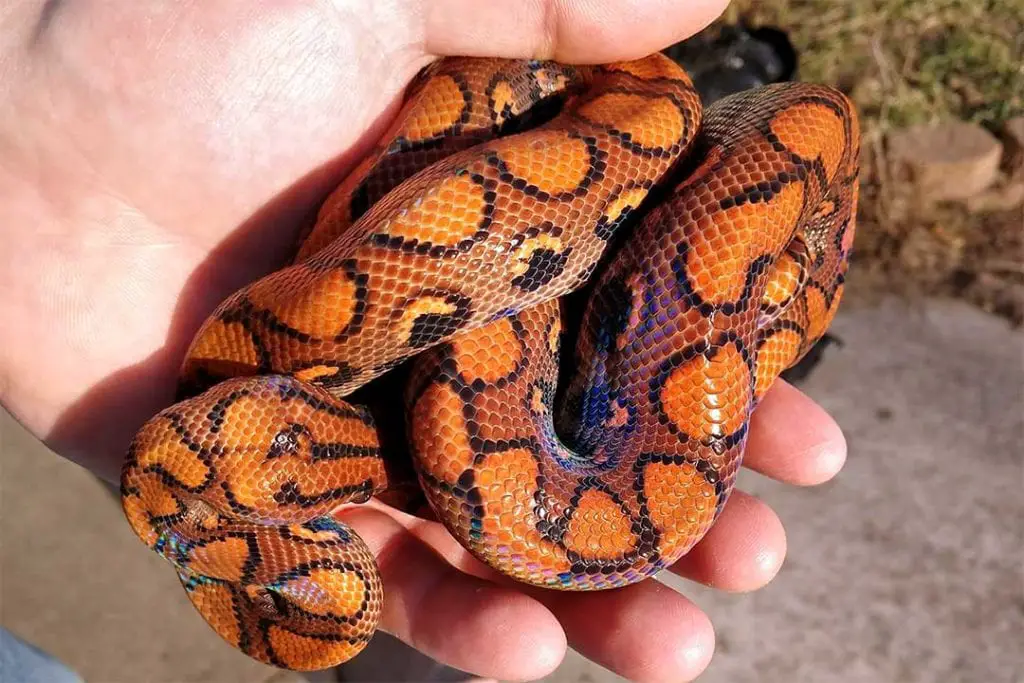
Brazilian rainbow boas are notorious for being shy snakes. As juvenile snakes, brazilian rainbow boas tend to be nippy and flighty. The best way to handle this is with short handling sessions until your snake relaxes around you.
You can start handling brazilian rainbow boas by using a snake hook to gently tap its body. Make sure your snake is awake before you approach. Once your snake is awake, use the snake hook to remove it.
Try to lift the snake from the middle of its body. Many keepers note that these snakes can be defensive of their enclosure, so taking them out before you touch them can help. Support as much of the body as you can.
Never squeeze or restrain your snake. Use your hands to gently guide them where you want them to go. Keep any handling sessions under about 5 minutes to start.
Once your snake is more comfortable, you can increase the time you spend handling them. Handle no more than twice a week, and never within 2 days of a meal.
If your snake bites you, do not drop it or pull away (don’t worry either, it’s nor painful and rainbow boas are not venomous). If you put the snake back immediately, it will learn that biting will get it put away faster and will do this more often. Snakes do learn, so do not teach them bad habits.
Common Issues
Here are a few common problems that Brazilian rainbow boas can have, some can happen even if you do provide good care.
If your question isn’t answered, please leave it in the comments.
My Rainbow Boa isn’t Eating
Rainbow boas are typically pretty good feeders. However, they can stop eating. If you are feeding them before the snake has digested the last meal, it will refuse.
Wait until your snake defecates before offering another meal. If the temperatures are too hot or cold, your snake may refuse to eat.
Check them with a temperature gun and give your snake about two weeks to adjust to any changes. If your snake is in shed or ready to breed, it may refuse meals.
This is normal, wait until they are finished. Stressed snakes will refuse to eat. Check that nothing is bothering your snake. Then, leave it alone as much as you can for two weeks to allow it to relax.
This means no handling and only open the enclosure to give water and clean. Illness can also put snakes off their food. Check your snake for any symptoms and take it to your reptile vet.
Rainbow boas can withstand missing a few meals. If your snake keeps up a feeding strike, watch its weight and body condition. If its spine becomes more prominent and the snake loses weight, you need to take it in.
Regurgitated Food
Regurgitation is very dangerous for snakes.
It is a last ditch attempt to escape a predator. It can also be because the prey was too big or the snake realized that something was wrong and it would make it sick.
If your snake regurgitated a meal, you will need to give it 2 weeks to heal before trying to feed it again.
Make sure you don’t handle your snake before or after a meal. While some people suggest feeding in a separate enclosure, the movement between them can stress your snake and make it regurgitate.
You can offer prey in a plastic box if you are worried about your snake ingesting substrate. Some snakes do prefer taking prey from containers, so this can work.
Illnesses
Brazilian rainbow boas can face many illnesses in captivity. Keep an eye on any feces and watch for changes. It should be brown and may contain fur but not much else.
If you see a change in color or lots of undigested parts of prey then your snake may have a parasite. A firm lump in the stomach when your snake hasn’t eaten in the past few days can also indicate parasites or bacterial infections.
Respiratory illnesses frequently have symptoms like heavy breathing, wheezing, and excess mucus. You may also see your snake have dented eyes if it is dehydrated.
If your snake is suddenly irritable or has any changes in color, your snake may be sick. A sick snake may be in pain and will be much less patient with handling.
Watch for changes in habits since these can also indicate that there is a problem. Many captive snakes deal with mites. These mites look like black specs about the size of a poppy seed.
Many snakes try to soak them off, so check the water for floating specs. If you notice any changes in behavior or signs of illness, take your snake to your reptile vet.
Most problems can be taken care of if they are caught early enough, and rainbow boas can live a long life in captivity.
You should be taking your snake at least once a year so that your vet has a record to compare your snake to. Unlike cats and dogs, normal levels for snakes have not been fully established.
Sources
- Epicrates cenchria (Salamanta; Rainbow Boa). Diet.
- Brazilian rainbow boa – Smithsonian’s National Zoo
- Parthenogenesis in a Brazilian rainbow boa (Epicrates cenchria cenchria)
Conclusion
We hope this Brazilian rainbow boa care sheet has helped you learn how to take care of these beautiful snakes. Brazilian rainbow boas are stunning and are wonderful to observe.
While you may not see your snake too often, and they can be a bit more difficult to care for if you are a beginner snake owner, these slender bodied snakes native to south america are still a treat to watch.
If you are interested in different morphs like albino, calico, caramel, anery and more, make sure to checkout my list of rainbow boa color morphs.
If you have any questions or comments, be sure to leave them below!
